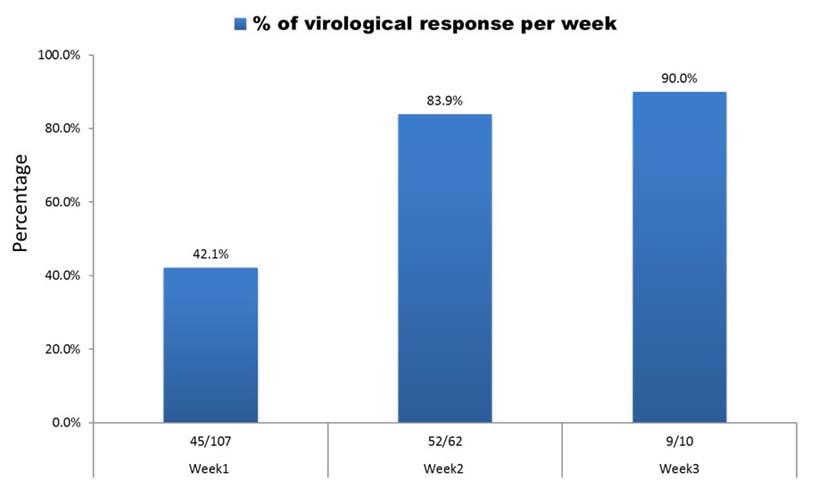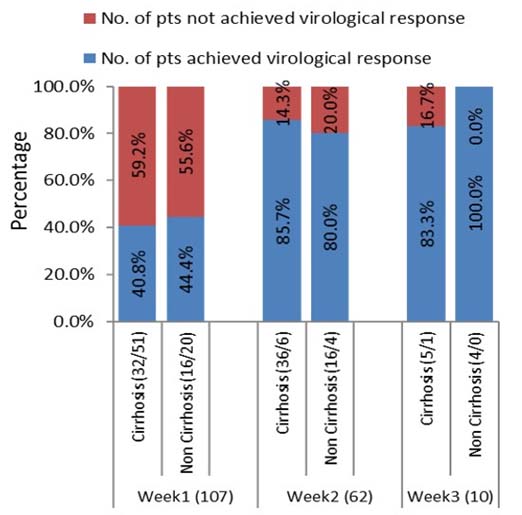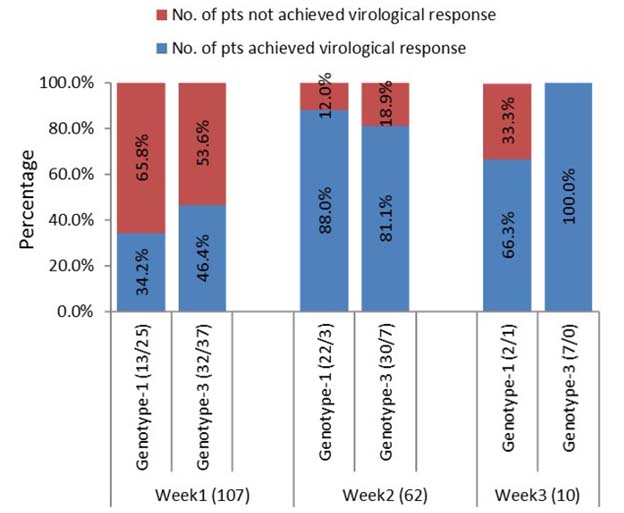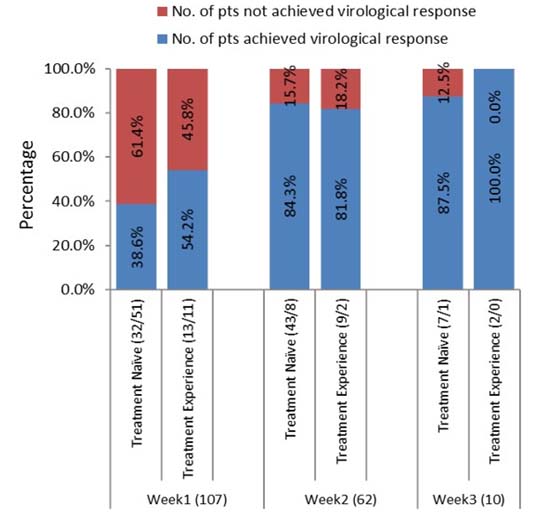Early Experience of Sofosbuvir based Combination Therapy in “Real-Life” Cohort with Chronic Hepatitis-C Infection
Rajiv Mehta1, Mayank Kabrawala2, Subhash Nandwani3, Rini Tekriwal4, Payal Nandania5
1 Consultant Gastroenterologist, Department of Gastroenterology, Surat Institute of Digestive Sciences (SIDS), Surat, Gujarat, India.
2 Consultant Gastroenterologist, Department of Gastroenterology, Surat Institute of Digestive Sciences (SIDS), Surat, Gujarat, India.
3 Consultant Gastroenterologist, Department of Gastroenterology, Surat Institute of Digestive Sciences (SIDS), Surat, Gujarat, India.
4 Research Scholar, Department of Physiology, Government College, Surat, Gujarat, India.
5 Research Scholar, Department of Physiology, Government College, Surat, Gujarat, India.
NAME, ADDRESS, E-MAIL ID OF THE CORRESPONDING AUTHOR: Dr. Rajiv Mehta, Consultant Gastroenterologist, Department of Gastroenterology, Surat Institute of Digestive Sciences (SIDS), Surat-395002, Gujarat, India.
E-mail: rmgastro@yahoo.com
Introduction
There is scarcity of data in literature regarding the treatment response with Sofosbuvir (SOF) based therapy in Indian patients with chronic Hepatitis-C Virus (HCV) infection.
Aim
This study was designed to observe initial treatment response to SOF based therapy in a “real-life” cohort of Indian patients with HCV infection.
Materials and Methods
This is a prospective, observational and single center study. A total of 107 patients who were diagnosed with chronic HCV infection and received SOF based treatment between March 2015 and December 2015 were included. The patients were treated with either triple drug regimen [SOF, Ribavirin (RBV) and Pegylated Interferon-α (Peg IFN-α)] or dual drug regimen (SOF and RBV) for either 12 or 24 weeks. The virological responses were obtained at baseline and thereafter weekly (up to four weeks) till viral load became undetected during treatment.
Results
A total of 107 patients who received SOF based therapy for chronic HCV infection were included in the study. Mean age of the patients was 48.7±10.7 years. Among included patients, 24 (22.4%) patients were treatment-experienced. Majority of the patients (n=69; 64.5%) were infected with HCV genotype-3. Except one patient, all the included patients achieved virological response up to week-4 of the treatment. There was statistically insignificant association between virological response (up to four week of the treatment) and severity of the disease (cirrhosis and non-cirrhosis) or treatment status (treatment-naïve and treatment-experienced), or HCV genotype (genotype-1 and 3).
Conclusion
The results of this observational study demonstrated rapid initial virological response of SOF based therapy in “real-life” cohort of Indian patients with chronic HCV infection. However, long-term follow-up data are needed to ensure the sustained antiviral efficacy of SOF based therapy.
Direct acting antivirals, Genotype-1, Genotype-3, Pegylated interferon, Ribavirin
Introduction
It is estimated that 180 million people are chronically infected with HCV worldwide and 350000-500000 HCV related deaths are reported annually [1,2]. The prevalence of HCV infection in India vary widely, ranging from 0.09% to 2.02% [3].
Until recently, the standard of care for treating chronic HCV infection has been Pegylated Interferon-α (Peg IFN-α) with ribavirin (RBV) for 24 to 48 weeks, depending upon genotype and severity of the liver disease [4]. In India, approximately 17,000 patients with HCV received treatment with Peg IFN-α/RBV but sustained virological response was achieved in only about 65% of patients [5]. However, the treatment has evolved from Peg IFN-α and RBV to direct acting antiviral agents.
SOF is a selective, pangenotypic nucleotide inhibitor of NS5B-directed HCV RNA replication. SOF based treatment has been proved safe and well tolerated in clinical trials [6,7]. However, data are scarce in literature regarding the treatment response with SOF based therapy in Indian patients with chronic HCV infection. Thus, in this prospective study, we aimed to study initial virological response to SOF based treatment regimens (SOF, RBV and Peg IFN-α/SOF and RBV alone) in our “real-life” cohort.
Materials and Methods
This is a prospective, observational and single center study. We enrolled patients who were diagnosed with chronic HCV infection and received SOF based treatment (SOF, RBV and Peg IFN-α/SOF and RBV alone) for chronic HCV infection between March 2015 and December 2015 at Surat Institute of Digestive Science, Surat, Gujarat, India. The patients were excluded if there was co-infection with HIV or Hepatitis-B virus.
Diagnosis of chronic HCV was based on detection of HCV RNA in serum or plasma by a quantitative reverse transcription polymerase chain reaction assay (Abbott Molecular Inc., IL, USA; lower level of quantification, 15 IU/ml). HCV genotyping was performed by reverse hybridization assay (Abbott Molecular Inc., IL, USA). The diagnosis of cirrhosis was established based upon either biochemical [Aspartate Aminotransferase to Platelet Ratio Index (APRI)] or ultrasonographic evaluation or transient elastography (Fibroscan score of more than 12.5 kPa) or endoscopic findings. We also assessed severity of liver disease based upon Child-Pugh Score, Model of End-stage Liver Disease Score (MELD Score) and evaluation of clinical signs of advanced cirrhosis, e.g., ascites, hepatic encephalopathy, clinical jaundice and presence of variceal hemorrhage.
The patients were treated with either triple drug regimen (SOF+ Peg IFN-α/ RBV) or dual drug regimen (SOF+RBV) for either 12 or 24 weeks. The treatment regimen as well as duration was left upon discretion of physicians. SOF was administered at 400 mg once daily and Peg IFN-α was administered at a dosing of 180 μg once weekly. RBV was administered depending upon the genotype of HCV i.e., 800 mg for genotype-3 HCV and 1000-1200 mg for genotype-1 [8]. The virologic responses were obtained weekly till viral load becomes undetected (documentation of HCV RNA <15 IU/mL) during treatment.
Informed consent was taken from all the enrolled patients. Institutional Ethics Committee approved the protocol. The study was conducted in accordance with the Guidelines for Good Clinical Practice and the Declaration of Helsinki.
Statistical Analysis
Continuous data were expressed by mean values and standard deviation. Categorical variables were expressed as absolute and relative numbers. Chi-square test or Fisher Exact test was used whenever required and p-value <0.05 was considered statistically significant. Statistical analysis was performed using Statistical Package for Social Science (SPSS; Chicago, IL, USA) program, version 15.
Results
During the study period, a total of 112 patients were diagnosed with HCV infection at our tertiary care centre. However, three patients had co-infection with HIV and two patients had co-infection with hepatitis-B virus and hence were excluded. The baseline characteristics of included 107 patients are shown in [Table/Fig-1]. The mean age of the patients was 48.7±10.7 years. In our “real-life” study cohort, 53 patients (49.5%) were diagnosed with compensated cirrhosis and 18 patients (16.8%) were having decompensated cirrhosis. Among included patients, 24 (22.4%) patients were treatment-experienced. Most patients (64.5%) were infected with HCV genotype-3. Baseline HCV RNA level was 5.6±0.9 (log10IU/ml).
Baseline characteristics of the patients with hepatitis-C virus infection. 1-Model of end stage liver disease score, 2-Hepatitis-C virus
| Parameters | Patients (n=107) |
|---|
| Age (years), mean±standard deviation | 48.7±10.7 |
| Gender |
| Male, n (%) | 49 (45.8%) |
| Female, n (%) | 58 (54.2 %) |
| Presentation |
| Chronic hepatitis, n (%) | 36 (33.6%) |
| Compensated cirrhosis, n (%) | 53 (49.5%) |
| Decompensated cirrhosis, n (%) | 18 (16.8%) |
| Child-Pugh Score, mean±standard deviation | 6.8±2.2 |
| MELD1 Score, mean±standard deviation | 11.1±5.6 |
| HCV RNA (log10IU/ml), mean±standard deviation | 5.6±0.9 |
| HCV2 genotype |
| Genotype 1, n (%) | 38 (35.5%) |
| Genotype 3, n (%) | 69 (64.5%) |
| Treatment Status |
| Treatment Naïve, n (%) | 83 (77.6%) |
| Treatment Experience, n (%) | 24 (22.4%) |
| HCV Treatment | |
| Dual drug therapy, n (%) | 98 (91.6%) |
| Triple drug therapy, n (%) | 9 (8.4%) |
The virological response of the patients up to week-3 of the treatment has been depicted in [Table/Fig-2]. All included patients (107 patients) were screened at week-1 and out of which 45 patients achieved virological response (documentation of HCV RNA<15 IU/ml). Fifty two patients achieved virological response out of remaining 62 patients who did not achieve virological response and therefore screened at week-2. At week-3, only one patient among remaining 10 patients, who did not achieve virological response and therefore were screened at week-3. We also performed virological response of all the patients at week-4 and virological response was achieved in all the patients except one. Virological response in different subgroups i.e., cirrhosis vs. non-cirrhosis, genotype-1 vs. genotype-3 and treatment experienced vs. treatment-naïve has been shown in [Table/Fig 3,4 and 5]. As shown in [Table/Fig-6], there is statistically insignificant association between virological response and disease severity i.e., cirrhosis and non-cirrhosis. Similarly, the association between virological response and HCV genotype i.e., genotype-1 and genotype-3 as well as the association between virological response and treatment status of the patient i.e., treatment-naïve and treatment-experienced was statistically insignificant [Table/Fig-6].
Virological response of the study patients up to three weeks.

Virological response of the study patients up to three weeks according to cirrhotic status up to three weeks.

Virological response of the study patients up to three weeks according to genotype of hepatitis C virus up to three weeks.

Virological response of the study patients up to three weeks according to treatment status up to three weeks.

Association between initial virological response and disease status, genotype and treatment status.
| Disease-status | p- value | Genotype | p- value | Treatment status | p- value |
|---|
| Week-1 | Cirrhosis(32/51) | 0.722 | Genotype-1(13/25) | 0.222 | Treatment Naïve(32/51) | 0.172 |
| Non Cirrhosis(16/20) | Genotype-3(32/37) | Treatment Experience(13/11) |
| Week-2 | Cirrhosis(36/6) | 0.714 | Genotype-1(22/3) | 0.726 | Treatment Naïve(43/8) | 1.000 |
| Non Cirrhosis(16/4) | Genotype-3(30/7) | Treatment Experience(9/2) |
| Week-3 | Cirrhosis(5/1) | 1.000 | Genotype-1(2/1) | 0.300 | Treatment Naïve(7/1) | 1.000 |
| Non Cirrhosis(4/0) | Genotype-3(7/0) | Treatment Experience(2/0) |
Chi-square test or Fisher Exact test was performed.
[Table/Fig-7] enlisted adverse events experienced by study population. The most common adverse event was anemia.
Adverse events experienced by study population.
| Adverse Events | n |
|---|
| Anemia | 19 |
| Bodyache | 3 |
| Fever | 2 |
| Itching (or Pruritis) | 2 |
| Joint pain (or Arthralgia) | 1 |
| Tremor | 1 |
Discussion
Till date, six major HCV genotypes and more than 120 subtypes of the HCV have been identified worldwide [9]. However, HCV burden and different HCV genotypes are distributed unevenly worldwide [10]. In India, epidemiological studies revealed genotype-3 to be the predominant type, followed by genotype-1 in Northern and Southern India [11–14] Lole KS et al., have reported prevalence of genotype-4 and 5 in Western India [15]. In our study, the patients were infected with either genotype-3 (64.5%) or genotype-1 (35.5%). None of the included patient was infected with genotype-4 or 5.
This is the first prospective study in India reporting initial results of SOF based therapy in “real-life” patients with chronic HCV infection. When this study was initiated, there was no approved treatment guidelines for SOF based therapy for Indian patients with HCV. Hence, the physicians involved in the study treated the patients with different SOF based treatment regimens. After the commencement of the therapy, we obtained virological responses weekly till viral load became undetected (documentation of HCV RNA <15 IU/ml) during treatment. We observed that all the patients except one achieved virological response before week-4 even though the study included considerable number of patients with cirrhosis (49.5% patients with compensated cirrhosis and 16.8% patients with decompensated cirrhosis) and treatment-experienced patients (22.4%). Thus, our study cohort demonstrated rapid initial virological response with SOF based therapy. Cho Y et al., reported real-life experience of SOF based therapies (SOF or SOF /ledipasvir plus RBV per day) [16]. Total 25 patients (19 patients with HCV genotype-1 infection and six patients with HCV genotype-2 infection) were included in this retrospective study and virological response was achieved in 15 patients with HCV genotype-1 (78.9%) and five patients with genotype-2 (83.3%).
Viral genotype historically had a major impact on treatment responsiveness. Patients with chronic HCV genotype-1 have been considered as “difficult to cure” genotype and thereby they had been treated with Peg IFN-α/RBV for 48 weeks [17]. We carried out analysis to observe whether in our study patient with genotype-1 showed slower initial virological response or not. However, there was statistically insignificant association between virological response (up to three week of the treatment) and genotype of HCV. (genotype-1 and 3). Similarly, there was statistically insignificant association between virological response (up to three week of the treatment) and severity of the disease (cirrhosis and non- cirrhosis) or treatment status (treatment-naïve and treatment-experienced).
Limitation
A few limitations of the study need to be addressed. One of the major limitation of the study is smaller sample size. Another limitation of the study is that the adherence to the study drug could not be rigorously evaluated.
Conclusion
In conclusion, the results of this observational study demonstrated rapid initial virological response of SOF based therapy in “real-life” cohort of Indian patients with chronic HCV infection. However, long-term follow-up data are needed to ensure the sustained antiviral efficacy of SOF based therapy.
Chi-square test or Fisher Exact test was performed.
[1]. Shepard CW, Finelli L, Alter MJ, Global epidemiology of hepatitis C virus infectionLancet Infect Dis 2005 5(9):558-67. [Google Scholar]
[2]. Hepatitis C. Fact sheet No. 164. Revised June 2011: World Health Organization; 2011 [20/04/2016]. Available from: http://www.who.int/mediacentre/factsheets/fs164/en/ [Google Scholar]
[3]. Mukhopadhya A, Hepatitis C in IndiaJ Biosci 2008 33(4):465-73. [Google Scholar]
[4]. Puri P, Anand AC, Saraswat VA, Acharya SK, Sarin SK, Dhiman RK, Consensus statement of HCV Task Force of the Indian National Association for Study of the Liver (INASL). Part II: INASL recommendations for management of HCV in IndiaJ Clin Exp Hepatol 2014 4(2):117-40. [Google Scholar]
[5]. Puri P, Anand AC, Saraswat VA, Acharya SK, Dhiman RK, Sarin SK, Indian National Association for Study of the Liver (INASL) guidance for antiviral therapy against HCV infection in 2015J Clin Exp Hepatol 2015 5(3):221-38. [Google Scholar]
[6]. Lawitz E, Lalezari JP, Hassanein T, Kowdley KV, Poordad FF, Sheikh AM, Sofosbuvir in combination with peginterferon alfa-2a and ribavirin for non-cirrhotic, treatment-naive patients with genotypes 1, 2, and 3 hepatitis C infection: A randomised, double-blind, phase 2 trialLancet Infect Dis 2013 13(5):401-08. [Google Scholar]
[7]. Bourlière M, Oules V, Ansaldi C, Adhoute X, Castellani P, Sofosbuvir as backbone of interferon free treatmentsDig Liver Dis 2014 46:S212-20. [Google Scholar]
[8]. Strader DB, Wright T, Thomas DL, Seeff LB, Diagnosis, management, and treatment of hepatitis CHepatology 2004 39(4):1147-71. [Google Scholar]
[9]. Khaja M, Munpally S, Hussain M, Habeebullah C, Hepatitis C virus: The Indian scenarioCurrent Science-Bangalore 2002 83(3):219-24. [Google Scholar]
[10]. Gower E, Estes C, Blach S, Razavi-Shearer K, Razavi H, Global epidemiology and genotype distribution of the hepatitis C virus infectionJ Hepatol 2014 61(1):S45-57. [Google Scholar]
[11]. Chakravarti A, Verma V, Distribution of hepatitis C virus genotypes in beta-thalassaemic patients from Northern IndiaTransfus Med 2006 16(6):433-38. [Google Scholar]
[12]. Hissar SS, Goyal A, Kumar M, Pandey C, Suneetha P, Sood A, Hepatitis C virus genotype 3 predominates in North and Central India and is associated with significant histopathologic liver diseaseJ Med Virol 2006 78(4):452-58. [Google Scholar]
[13]. Raghuraman S, Shaji R, Sridharan G, Radhakrishnan S, Chandy G, Ramakrishna B, Distribution of the different genotypes of HCV among patients attending a tertiary care hospital in south IndiaJ Clin Virol 2003 26:61-69. [Google Scholar]
[14]. Christdas J, Sivakumar J, David J, Daniel H, Raghuraman S, Abraham P, Genotypes of hepatitis C virus in the Indian sub-continent: A decade-long experience from a tertiary care hospital in South IndiaIndian J Med Microbiol 2013 31(4):349 [Google Scholar]
[15]. Lole KS, Jha JA, Shrotri SP, Tandon BN, Prasad VM, Arankalle VA, Comparison of hepatitis C virus genotyping by 5 noncoding region-and core-based reverse transcriptase PCR assay with sequencing and use of the assay for determining subtype distribution in IndiaJ Clin Microbiol 2003 41(11):5240-44. [Google Scholar]
[16]. Cho Y, Cho EJ, Lee JH, Yu SJ, Yoon JH, Kim YJ, Sofosbuvir-based therapy for patients with chronic hepatitis C: Early experience of its efficacy and safety in KoreaClin Mol Hepatol 2015 21(4):358-64. [Google Scholar]
[17]. Ghany MG, Strader DB, Thomas DL, Seeff LB, Diagnosis, management, and treatment of hepatitis C: An updateHepatology 2009 49(4):1335-74. [Google Scholar]